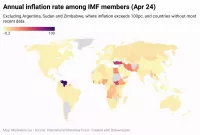A recession is an economic contraction marked by a broad decline in economic activity, often triggered by a drop in spending. Common causes include financial crises, trade shocks, supply shocks, bursting economic bubbles, and large-scale disasters. While there isn't a universally agreed-upon definition, a recession signifies a downturn in the business cycle.
1929: Reference to the Stock Market Crash of 1929
The text references the stock market crash of 1929 in comparison to the Black Monday collapse of October 1987. Although the 1987 collapse was larger, the global economy recovered more quickly.
1931: Start of Australia's biggest recession
In 1931, Australia experienced the start of its biggest recession in history due to profit issues in agriculture and cutbacks.
1932: Continuation of Australia's biggest recession
In 1932, Australia continued experiencing its biggest recession in history, influenced by poor economic states of other nations and dependence on them for export and foreign investments.
1947: NBER did not declare recession despite two quarters of declining GDP
In 1947, the NBER did not declare a recession in spite of two quarters of declining GDP, due to strong economic activity reported for employment, industrial production, and consumer spending.
1948: Stock Market Declines Preceding Recessions
Since 1948, ten recessions were preceded by a stock market decline, by a lead time of 0 to 13 months (average 5.7 months), while ten stock market declines of greater than 10% in the Dow Jones Industrial Average were not followed by a recession.
1949: W-shaped Recession in the US
In 1949, the US experienced a W-shaped recession (double-dip recession).
1950: Decline in spending
The 6.4% decline in spending during Q3 of 2008 on non-durable goods, like clothing and food, was the largest since 1950.
1954: V-shaped recession in the US
In 1954, the US experienced a V-shaped recession, characterized by a short and sharp economic contraction followed by a rapid and sustained recovery.
1961: Brief recession in Australia
In 1961, Australia experienced a brief recession due to a credit squeeze.
1970: Start of Qualifying Periods for Global Recessions
Since 1970, six periods qualify as global recessions based on the IMF's criteria, highlighting significant economic downturns.
1973: Rising inflation in Australia due to oil crisis
In 1973, Australia faced a rising level of inflation, partially caused by the oil crisis, leading to a 13% increase in inflation.
1974: Global Recession Period
1974 marked a period that qualified as a global recession based on the IMF's criteria.
1974: Bureau of Labor Statistics Defines Recession
In 1974, Julius Shiskin, Commissioner of the Bureau of Labor Statistics, proposed a quantitative definition of a recession in The New York Times article based on the bureau's qualitative definition.
1974: U-shaped Recession in the US
In 1974, the US experienced a U-shaped recession, characterized by a prolonged economic slump.
1974: Economic recession in Australia
In mid-1974, Australia was hit by an economic recession, and the government did not enact any policy changes to counter the economic situation, leading to rising unemployment and an increasing trade deficit.
1975: Global Recession Period
1975 marked a period that qualified as a global recession based on the IMF's criteria.
1975: U-shaped Recession in the US
In 1975, the US experienced a U-shaped recession, characterized by a prolonged economic slump.
1980: Global Recession Period
1980 marked a period that qualified as a global recession based on the IMF's criteria.
1980: Start of observation period for US economic cycles
From 1980 to 2018, there were only eight periods of negative economic growth over one fiscal quarter or more, and four periods considered recessions in the U.S.
1980: W-shaped Recession in the US
In 1980, the US experienced a W-shaped recession (double-dip recession).
1981: 1981 recession caused by tight-money policy
The 1981 recession is believed to have been caused by the tight-money policy adopted by Paul Volcker, chairman of the Federal Reserve Board. The policy was supported by Ronald Reagan, and the recession was called a "Reagan-Volcker-Carter recession."
1982: Global Recession
In 1982, according to the IMF's definition, a global recession took place. The recession lasted for only one year.
1982: W-shaped Recession in the US
In 1982, the US experienced a W-shaped recession (double-dip recession).
1983: Global Recession Period
1983 marked a period that qualified as a global recession based on the IMF's criteria.
October 1987: Major stock collapse (Black Monday)
In October 1987, a major stock collapse, known as Black Monday, occurred, leading to another recession in the early 1990s.
1990: Global Recession Period
1990 marked a period that qualified as a global recession based on the IMF's criteria.
1990: Japan's Great Recession Begins
In 1990, Japan's 'Great Recession' began, triggered by a collapse in land and stock prices, leading to negative equity for Japanese firms.
1990: V-shaped recession in the US
In 1990, the US experienced a V-shaped recession, characterized by a short and sharp economic contraction followed by a rapid and sustained recovery.
1991: Global Recession
In 1991, according to the IMF's definition, a global recession took place. The recession lasted for only one year.
1991: V-shaped recession in the US
In 1991, the US experienced a V-shaped recession, characterized by a short and sharp economic contraction followed by a rapid and sustained recovery.
1993: Global Recession Period
1993 marked a period that qualified as a global recession based on the IMF's criteria.
1993: U-shaped Recession in Japan
In 1993, Japan experienced a U-shaped recession, characterized by a prolonged economic slump.
1993: Potential extension of the 1991 recession
In 1993, the 1991 recession would have lasted three years (1991–1993) if the IMF had used the normal exchange rate weighted per capita real World GDP rather than the purchase power parity weighted per capita real World GDP as criteria.
1994: U-shaped Recession in Japan
In 1994, Japan experienced a U-shaped recession, characterized by a prolonged economic slump.
1998: Global Recession Period
1998 marked a period that qualified as a global recession based on the IMF's criteria.
1998: Japanese Firms Become Net Savers
After 1998, Japanese firms overall became net savers rather than borrowers, contributing to the balance sheet recession.
2001: Global Recession Period
2001 marked a period that qualified as a global recession based on the IMF's criteria.
2001: Recession in the U.S.
The 2001 recession in the U.S. did not involve two consecutive quarters of decline but was preceded by two quarters of alternating decline and weak growth.
2001: GDP decline
The third quarter of 2008 brought on a GDP retraction of 0.5%, the biggest decline since 2001.
April 2002: IMF Assesses Global Recessions
In April 2002, the IMF assessed that during the past three global recessions of the last three decades, global per capita output growth was zero or negative.
2003: Peak Decline in Corporate Investment in Japan
By 2003, corporate investment in Japan had fallen by 22% of GDP from 1990 due to firms paying down debts rather than investing.
December 2007: Peak of economic activity
According to the National Bureau of Economic Research in December 2008, December 2007 represented the peak of economic activity before the start of the recession.
December 2007: Start of recession and job losses
By December 2007, the US had begun a recession that lead to 5.1 million job losses by March 2009 and an unemployment rate of 8.5%.
2007: Start of the 2007-2009 recession
The 2007-2009 recession began, leading to a fall in private consumption for the first time in nearly 20 years, highlighting the recession's depth and severity.
2007: Start of US recession
The US entered a recession at the end of 2007, marking the beginning of what would become known as the Great Recession.
February 2008: U.S. employers shed jobs
In February 2008, U.S. employers shed 63,000 jobs, marking the most significant job loss in five years.
April 2008: Start of the recession (according to the Federal Reserve Bank of Philadelphia)
According to a November 2008 report from the Federal Reserve Bank of Philadelphia, the recession started in April 2008 and would last for 14 months.
April 2008: Greenspan says U.S. could go into recession
On April 6, 2008, former Federal Reserve chairman Alan Greenspan stated that there was more than a 50 percent chance the United States could enter a recession. On April 29, Moody's declared that nine US states were in a recession.
June 2008: Analysts state U.S. is in a recession
By June 2008, despite the U.S. economy growing in the first quarter by 1%, some analysts stated that the country was in a recession due to a protracted credit crisis and rampant inflation in commodities such as oil, food, and steel.
November 2008: Large job losses in the U.S.
In November 2008, U.S. employers eliminated 533,000 jobs, which was the largest single-month loss in 34 years.
November 2008: Federal Reserve Bank of Philadelphia report on recession
In November 2008, a report from the Federal Reserve Bank of Philadelphia suggested that the recession started in April 2008 and would last 14 months.
December 2008: NBER declares U.S. recession began in December 2007
In December 2008, the National Bureau of Economic Research (NBER) stated that the U.S. had been in a recession since December 2007, when economic activity peaked.
2008: Global Recession Period
2008 marked a period that qualified as a global recession based on the IMF's criteria.
2008: Economic Crisis of 2008 and Tax Policies
Gauti B. Eggertsson writes that cutting taxes on labor or capital is contractionary under certain circumstances, such as those that prevailed following the economic crisis of 2008, and that temporarily increasing government spending at such times has much larger effects than under normal conditions.
2008: Many nations follow US into recession
In 2008, following the US's entry into a recession at the end of 2007, many other nations also entered a recession.
March 2009: Job Losses and Unemployment Rate
In March 2009, the unemployment rate in the U.S. grew to 8.5%, and there were 5.1 million job losses since the recession began in December 2007. The increase in the number of unemployed persons was the largest annual jump since the 1940s.
April 2009: IMF changes Global Recession definition
In April 2009, the IMF changed its definition of a Global Recession to include a decline in annual per capita real World GDP (purchasing power parity weighted), backed by a decline or worsening of other global macroeconomic indicators.
April 2009: IMF Definition of Global Recession
Until April 2009, the International Monetary Fund (IMF) communicated that a global annual real GDP growth of 3.0% or less was considered 'equivalent to a global recession'.
June 2009: End of US recession of 2007
In June 2009, the US recession that began in 2007 officially ended, and the nation entered a period of economic recovery.
June 2009: End of the 2008/2009 recession
In September 2010, the National Bureau of Economic Research announced that the 2008/2009 recession ended in June 2009, making it the longest recession since World War II.
July 2009: Economists believe recession may have ended
By July 2009, a growing number of economists believed that the recession may have ended.
2009: Global Recession Period
2009 marked a period that qualified as a global recession based on the IMF's criteria.
2009: Lack of Consensus Predictions for Recessions
Analysis by Prakash Loungani found that there were zero consensus predictions one year earlier for the 49 recessions during 2009, highlighting the difficulty in predicting recessions.
2009: Krugman Describes U.S. Recession as Liquidity Trap
In 2009, economist Paul Krugman described the U.S. recession as a liquidity trap, where interest rates are near zero but ineffective in stimulating the economy.
2009: Continuation of Great Recession
In 2009, the effects of the Great Recession continued, with low consumer confidence leading to a prolonged economic recovery and U.S. consumers being severely impacted by dropping house values and decimated pension savings.
2009: Projected real GDP decline
In November 2008, the Federal Reserve Bank of Philadelphia projected real GDP declining at an annual rate of 2.9% in the fourth quarter of 2008 and 1.1% in the first quarter of 2009.
March 2010: Krugman Estimates Countries in Liquidity Trap
In March 2010, economist Paul Krugman estimated that developed countries representing 70% of the world's GDP were caught in a liquidity trap.
September 2010: NBER announces end of recession
On September 20, 2010, the National Bureau of Economic Research (NBER) announced that the 2008/2009 recession ended in June 2009.
December 2010: Krugman on Government Spending and Household Debt
In December 2010, Paul Krugman wrote that significant, sustained government spending was necessary because indebted households were paying down debts and unable to carry the U.S. economy as they had previously.
2010: Krugman Discusses Balance Sheet Recession
In 2010, Paul Krugman discussed the balance sheet recession concept, agreeing with Koo's situation assessment that sustained deficit spending is appropriate. He argued monetary policy could affect savings behavior.
July 2012: Survey on Balance Sheet Recession Research
In July 2012, a survey reported that consumer demand and employment are affected by household leverage levels, highlighting reduced consumption and employment due to higher household leverage.
2012: Recession in the Eurozone
In 2012, the Eurozone experienced a recession as the economies of the 17-nation region failed to grow during any quarter of the year. The recession deepened during the final quarter, affecting the French, German, and Italian economies.
2014: Krugman on Balance Sheet Recession
In 2014, economist Paul Krugman wrote that the financial crisis was a manifestation of excessive debt, calling it a "balance sheet recession".
2017: Insights on Economic Downturns by Patel
In 2017, Patel highlighted that comprehensive examination of factors like employment levels, household savings rates, corporate investment decisions, interest rates, demographics, and government policies provides insights into the complex dynamics that contribute to economic downturns.
2017: Tax Cuts and Jobs Act of 2017
In 2017, the Trump administration claimed that lower effective tax rates on new investment imposed by the Tax Cuts and Jobs Act of 2017 would raise investment, thereby making workers more productive and raising output and wages.
2018: End of observation period for US economic cycles
From 1980 to 2018, the U.S. experienced only eight periods of negative economic growth over one fiscal quarter or more, and four periods considered recessions.
2018: Recession Factors by Smith
In 2018, Smith noted that a recession includes declines in economic activity measures like GDP, consumption, investment, government spending, and net export activity.
2019: Investment Patterns Post-TCJA
By 2019, investment patterns in the United States indicated that the supply-side incentives of the TCJA had little effect on investment growth, with much of the increase being a response to oil prices.
2019: Insights on Economic Downturns by Anderson
In 2019, Anderson highlighted that comprehensive examination of factors like employment levels, household savings rates, corporate investment decisions, interest rates, demographics, and government policies provides insights into the complex dynamics that contribute to economic downturns.
February 2020: Start of COVID-19 recession
In February 2020, the NBER declared the start of a 2-month COVID-19 recession.
March 2020: Start of recession in Australia due to bush fires and COVID-19
In March 2020, Australia entered a recession due to the impact of huge bush fires and the COVID-19 pandemic's effects on tourism and other important aspects of the economy.
April 2020: End of COVID-19 recession
In April 2020, the NBER declared the end of a 2-month COVID-19 recession.
May 2020: End of recession in Australia
In May 2020, the recession that began in March 2020 in Australia ended. The recession was steep but short-lived.
2020: Recession Factors by Johnson & Thompson
In 2020, Johnson & Thompson indicated that a recession includes declines in economic activity measures like GDP, consumption, investment, government spending, and net export activity.
2020: Recession in the United Kingdom due to COVID-19
In 2020, the United Kingdom experienced a recession attributed to the COVID-19 global pandemic, marking the first recession since the Great Recession.
2021: Inflation Surge
In 2021 the inflation surge began and lasted up to 2023, which led to the Federal Reserve sharply increased the fed funds rate to combat it.
July 2022: Treasury Yield Curve Inversion Begins
In July 2022, the longest and deepest Treasury yield curve inversion in history began, as the Federal Reserve increased the fed funds rate to combat inflation.
2023: Inflation Surge
In 2023 the inflation surge began in 2021, and lasted until then, which led to the Federal Reserve sharply increased the fed funds rate to combat it.
June 2024: Yield Curve Begins Re-Steepening
In June 2024, the yield curve began re-steepening toward positive territory.
July 2024: Economists Predict Continued Growth Despite Inverted Yield Curve
By July 2024, despite predictions of an imminent recession, economic growth remained steady, and a Reuters survey of economists expected the economy to continue growing. An earlier survey of bond market strategists found a majority no longer believed an inverted curve to be a reliable recession predictor.
Mentioned in this timeline
The United States of America is a federal republic located...

The stock market serves as a platform where buyers and...
Hong Kong is a Special Administrative Region of the People's...

Inflation in economics signifies an increase in the average price...
Japan is an East Asian island country situated in the...
Korea is a peninsular region in East Asia comprised of...
Trending
4 months ago Fenerbahçe seeks advantage against 'Flying Dutchman,' Azeri TV cheers, stands with Palestine.
8 months ago Bucknell Sued After Hazing Allegedly Leads to Freshman Football Player's Death
29 days ago OpenAI's GPT-5.1: Smarter, Conversational ChatGPT with New Personalities and Improved Speed.

4 months ago Ranger Suárez's Future: Predictions of Departure and Potential $115 Million Contract.
6 months ago Dodgers Defeat Padres: Smith's Walk-Off Homer Secures Victory in Historic Game

Joy-Ann Reid is an American political commentator and television host known for her work on MSNBC She is best known...
Popular

Candace Owens is an American conservative political commentator and author...

Ilhan Omar is an American politician currently serving as the...
Matt and Ross Duffer known as the Duffer Brothers are...

XXXTentacion born Jahseh Dwayne Ricardo Onfroy was a controversial yet...

Tom Cotton is an American politician and Army veteran currently...
The Kennedy Center Honors are annual awards recognizing individuals and...